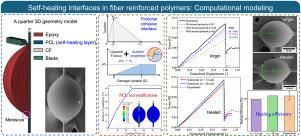纤维增强聚合物中的自愈界面:计算模型
IF 9.8
1区 材料科学
Q1 MATERIALS SCIENCE, COMPOSITES
引用次数: 0
摘要
纤维-基体界面对复合材料结构的耐久性起着至关重要的作用。开发自修复接口的前景可以为显著延长其使用寿命铺平道路。在这项研究中,我们研究了环氧/碳纤维复合材料界面纳米结构层的自修复潜力。建立了具有自修复纳米结构聚己内酯(PCL)层的环氧/碳纤维复合材料的三维热力学模型。建立了一种完全耦合的热应力模型来模拟界面的愈合过程。为了更好地捕捉该材料的真实界面特性,同时考虑了残余应力和表面粗糙度。模型中包含了温度相关的材料性能,并分析了PCL再结晶过程中的热量产生。通过将数值预测结果与该新型复合材料的微键测试数据进行比较,验证了该模型的有效性。数值结果表明,表面粗糙度提高了界面强度,而残余应力降低了界面强度。此外,修复过程不仅恢复了界面键,而且降低了修复材料中的热残余应力。这项研究为利用自修复界面来提高复合材料结构的耐久性提供了有价值的见解。本文章由计算机程序翻译,如有差异,请以英文原文为准。

Self-healing interfaces in fiber reinforced polymers: Computational modeling
Fiber-matrix interfaces play a critical role in determining the durability of composite structures. The prospect of developing self-healing interfaces could pave the way for significantly extending their service life. In this study, we investigate the self-healing potential of nanostructured layers at interfaces of epoxy/carbon fiber composites. A three-dimensional thermomechanical model of epoxy/carbon fiber composites with a self-healing nanostructured polycaprolactone (PCL) layer at fiber–matrix interfaces is developed. A fully coupled thermal-stress procedure is established to simulate the healing process of interfaces. To better capture the realistic interfacial properties of this material, both residual stress and surface roughness are considered. Temperature-dependent material properties are included in the model, and heat generation during PCL recrystallization is analyzed. The proposed model is validated by comparing numerical predictions with the microbond testing data of this novel composite material. Numerical results reveal that surface roughness enhances interfacial strength while residual stresses reduce it. Furthermore, the healing process not only restores the interface bonds but also reduces thermal residual stress in the healed material. This study provides valuable insights into leveraging self-healing interfaces to enhance the durability of composite structures.
求助全文
通过发布文献求助,成功后即可免费获取论文全文。
去求助
来源期刊

Composites Science and Technology
工程技术-材料科学:复合
CiteScore
16.20
自引率
9.90%
发文量
611
审稿时长
33 days
期刊介绍:
Composites Science and Technology publishes refereed original articles on the fundamental and applied science of engineering composites. The focus of this journal is on polymeric matrix composites with reinforcements/fillers ranging from nano- to macro-scale. CSTE encourages manuscripts reporting unique, innovative contributions to the physics, chemistry, materials science and applied mechanics aspects of advanced composites.
Besides traditional fiber reinforced composites, novel composites with significant potential for engineering applications are encouraged.
 求助内容:
求助内容: 应助结果提醒方式:
应助结果提醒方式:


